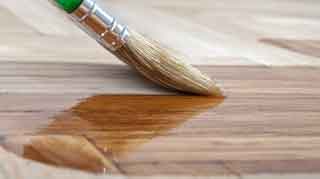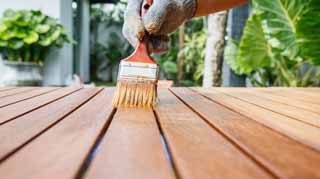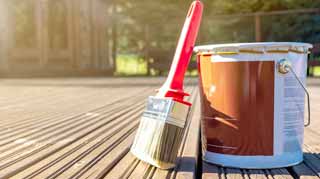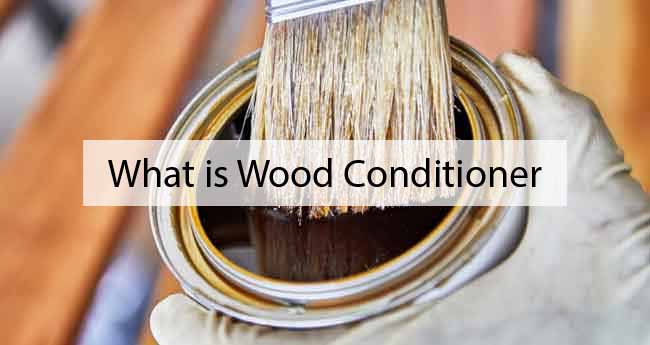To make wood lovely and attractive, it is very important to avoid all those dark spots of material that make wood look like the one we all once saw in our grandma's furniture.
These days no one wants an old looking ugly wood furniture. How to avoid those dark spots of wood? Because they don't just disappear!
For that purpose, woodworkers use wood conditioners. A wood conditioning is a simple pre-staining step in a wood project. It enhances the beauty of wood stain by protecting it from splotchy and un-even staining on wood. It is a treatment for better and even color.
Due to a wood conditioner, wood remains safe from any streaking and darker spotting. Wood conditioning is for all types of wood but it necessary for certain kinds of woods and cannot be skipped.
For example, working on woods like alder, birch, fir, and pine. These are all very porous type woods and are soft material. To stop them from blotching, being familiar with how to apply wood conditioner properly is a basic need for any woodworker.
So, What is a Wood Conditioner Actually?

A wood conditioner is used for pre-staining wood before finishing to prevent it from uneven and irregular stains. An uneven-staining is actually when a plank of wood becomes ugly due to irregular absorption of a wood stain across different parts.
This is the main reason behind a wood getting darker at various spots. A wood conditioner helps to prevent this from happening by temporarily sealing the wood to even out the rate of stain absorption.
There are two types of pre-staining wood conditioner:
1. An Oil-Based Wood Conditioner
An oil-based conditioner is used while working with an oil-based stain project. It is for even distribution of an oil-based stain over wood. It helps to make wood more attractive by preventing it from blotching and any kind of streaking.
2. Water-Based Wood Conditioner
Water-based wood conditioners are for water-based stains. Before applying any water-based stain, use a wood conditioner to ensure a consistent penetration of a stain.
A wood conditioner is an easily manufactured product. It is prepared by thinning one part of regular varnish or a polyurethane varnish with two parts of any paint thinner such as mineral spirits.
The main purpose of thinning a varnish is to reduce the ratio of any varnish to thinner and not completely sealing a wood. So, wood will prevent wood stain to go deep into the wood where blotching will occur.
Many brand's pre-stain wood conditioner consists of a high concentration of various solvents like naphtha carrying a dissolved solid amount of a styrene plastic or an alkyd resin.
Always check which wood conditioner will be best for your wood before applying. It depends on your wood and stain you are working with. Many wood stains always recommend a suitable wood conditioner.
How to Apply a Wood Conditioner? 3 Method Discussed

1. Minwax Wood Conditioner Applying Process:
Preparation:
- Make sure to properly sand your wood surface.
- Fill any kind of scratch and gouge on your wood
- Make sure to clean the wood surface from any glue residue.
- Use a vacuum and remove all dust.
- Also apply mineral spirit to make sure that there is no saw particle left.
Steps For Using It On Wood
After cleaning a wood surface properly, apply a moderate coat of pre-staining wood conditioner. Make sure to cover every spot on the wood surface. Always apply a wood conditioner in the direction of the wood grain.
Wait for about 15 minutes for a wood conditioner to penetrate. Now wipe off all excess from the wood. Use a brush or a piece of cloth for this purpose.
It is recommended with many wood stains to apply after 2 hours after wood conditioning. If your wood is extra absorbent, take a brush and apply a second coat of wood conditioner. Then again wait for it to penetrate. After that clean wood surface with a spirit.
It is important to take care of drying time during a wood conditioner application as extra drying of conditioner will only worsen your wood stain. While working with big projects, try to do wood conditioning in smaller segments for the best results.
Now apply a wood stain. Wait for it to dry. Your wood will be looking very attractive having a very smooth and uniform color.
2. Making Of Pre-Stain Wood Conditioner At Home and Use it
You can say that a wood conditioner is just a thinning of wood finish. It can be easily prepared at home. It is easy to use a solvent-based wood finish as compared to a water-based wood finish. Water-based finishes are complicated and just adding water to make it a conditioner does not make any sense.
By using wood finishes like varnish, shellac, and lacquer with suitable solvents, you can easily prepare a homemade conditioner.
For making a shellac wood conditioner, thin it out by using denatured alcohol. Try to make it a 50/50 solution of both shellac and denatured alcohol.
Test it on a piece of wood and if it doesn't allow a wood stain to properly penetrate, add more amount of denatured alcohol for thinning shellac finish. Again, test it and keep thinning it until your wood conditioner is ready.
For a varnish-based wood conditioner, make a solution by thinning it with turpentine or with mineral spirits. Quantity of both varnish finish and mineral spirit depends on what type of wood you are using.
You can start thinning it with the same percentage of both and then if it doesn't work for your wood, start reducing the amount varnish in the solution.
For a lacquer thinner, make a solution by using a lacquer thinner. You should always thin a lacquer finish by considering atmospheric humidity. If humidity is high, use this thinner at a low evaporation rate so moisture will not get trapped in the wood.
Start to test a lacquer wood conditioner by half amount of both. Apply a coat of it and let it dry. Now apply stain over it. If stain color is too light, start thinning your solution.
3. Spoon Butter - Wood Conditioner Using Tips

Spoon butter is also a type of wood conditioning also called wood butter. It is not something to eat for yourself but food for your wood to regain its lost shine. It is not a pre-staining wood conditioner but works by moisturizing dried wooden implements especially kitchenware.
Materials you will need to make it are as follows:
- Beeswax
- Coconut oil
- Grapeseed oil or a walnut oil
Take a double boiler and combine all three ingredients. For this combination, use two parts of coconut oil for one part of beeswax. add a very small amount of grapeseed oil. Now after combining place your double boiler over a pot of simmering water.
Slowly melt the ingredients by stirring. Use a low to medium heat. After melting down all the ingredients especially beeswax, quickly remove the boiler from the pot and turn off your stove. Now pour the mixture into a jar before it starts to harden by cooling.
Now leave the jar for several hours and wait for the mixture to dry. Your wood butter is ready and you can use it to heal any wooden material like spoons, cutting board, etc. For applying, use a thin layer of it and then wait for it to get dry. After that, use an old rag to buff any extra wood butter from wood. The surface of the wood should feel smoother and not sticky.
Safety Issues That You Should Take Care While Applying it
- Always use a glove and apron before using a wood conditioner. If any symptoms occur after getting in touch with the wood conditioner seek medical attention.
- For eye contact, if you are wearing any contact lenses, remove them first and wash your eye with water by lifting upper and lower eyelids for at least 20 minutes. Wash your hands properly after skin contact.
- If you have inhaled some kindly go to the fresh air. Wear light clothes and try to inhale more oxygen. If still breathing is irregular, use artificial oxygen.
- Keep it away from children and any heat or fire. Use it in a properly ventilated workplace. Keep conditioner lid tightly closed when not using. Always wash your hands after using it.
Water-based and oil-based conditioners must be tested before using on wood. Take a sample and apply it to your wood with a brush and apply the stain. If your wood is getting uglier and is not looking evenly stained, do not use that wood conditioner.

Conclusion
Hope our guide on how to apply a wood conditioner is very easy to understand, if you followed the proper application instructions that we mentioned above. For better coverage of wood stain, it is a necessary step to use a wood conditioner.
Before using any wood conditioner, make sure that it will work fine with your wood as different woods have different natures depending on the moisture and thickness. If you have already selected your wood stain then it is suggested to buy a wood conditioner compatible with wood stain.
- How to Choose Wood Filament: A Complete Guide - July 17, 2021
- 10 Best Propane Forge Reviews - June 30, 2021
- Best Circular Saw Blade for Plywood : Top 10 Picks - June 30, 2021



Can I use varathane wood conditioner on my maple and walnut bread knife bare wood before I add Godard’s butcher block oil? Is it even required? Pls let me know asap